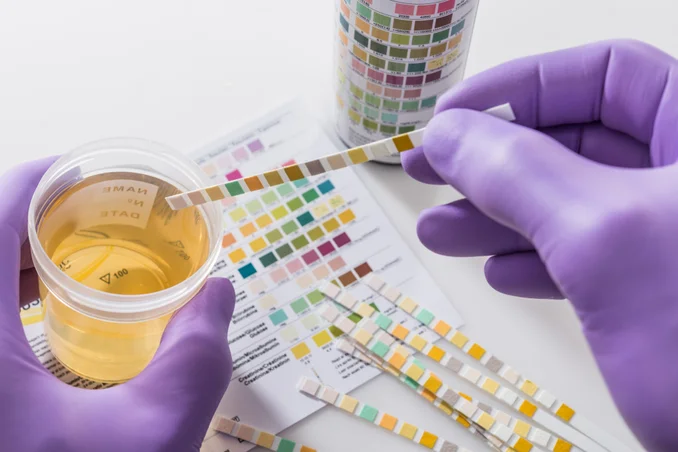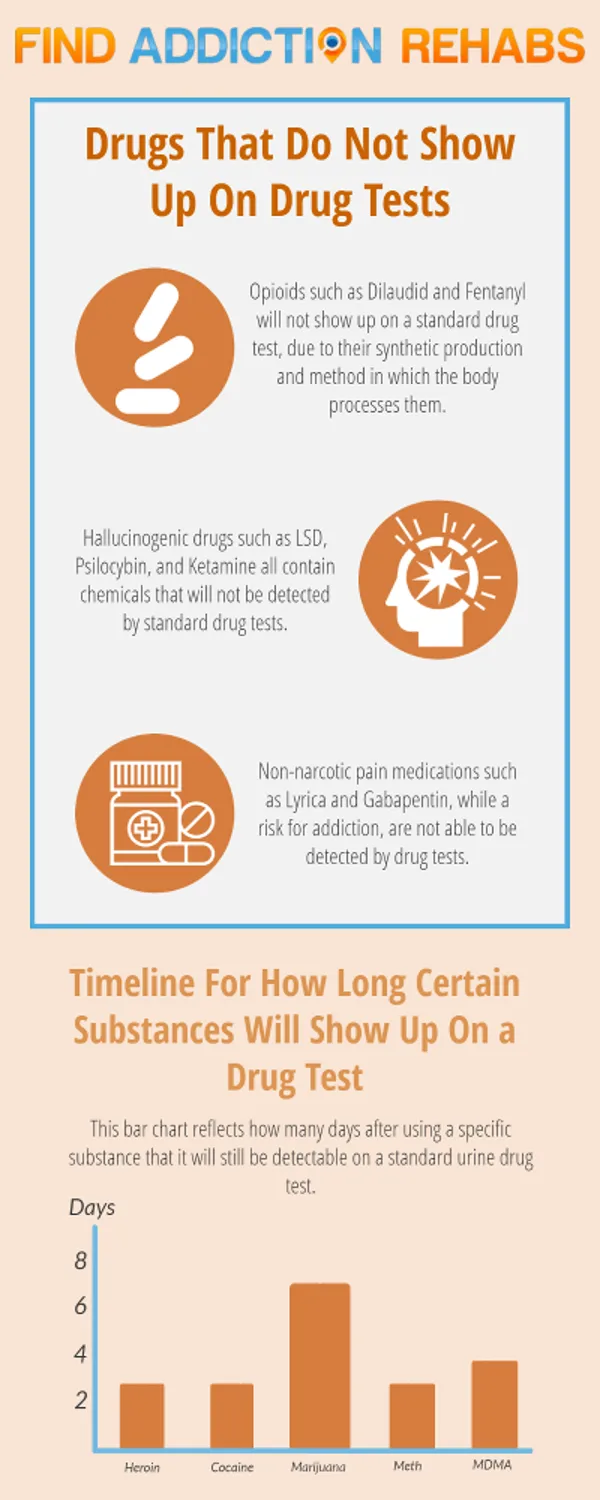Are There Substances That Can Not Be Detected by a Standard Drug Test?
Before answering this question, it is important to acknowledge that this information is being provided as a means of education. For individuals who have loved ones who are struggling with substance abuse, knowing which substances will and will not show up on drug tests can be crucial information.
However, if you are here reading this because you are struggling with addiction, know that you are not alone, and help is available. Call our 24/7 hotline today to start finding treatment options that work for you.
When it comes to drug testing, these are often standardized and are designed to detect specific drugs. These urine tests (or any other form of drug test) often seek to discover the most commonly abused substances.
Of course, this does in fact leave other drugs free to slip under the radar. Furthermore, different types of drug tests will vary in their ability to register a substance based on the amount, method, and type taken.
What is a Standard Drug Test?

The most common drug tests are typically 10 to 15-panel drug tests, or urine drug tests, as they are cheap, effective, and typically produce results within minutes. Furthermore, they are easily acquired, typically available at most convenience stores, or occasionally at certain gas stations and head shops (tobacco or smoke shops).
Saliva tests and blood tests may also be viable options for some, although they are less popular (and typically more invasive) choices.
While additional methods of drug testing that can test for a more specific drug do exist, these are often quite time-consuming and can be extremely expensive to acquire.
Drug and alcohol rehabilitation centers typically will use the most common form of drug tests, in which urine samples are used to detect substance use in patients. However, they will occasionally send the results of these urine tests to labs for further investigation, or a more thorough diagnostics report.
This additional analysis can produce results for drug use that standard 12-panel drug tests may not be able to.
24 Hour Substance Abuse Helpline – Call Us Now!
(877) 633-0053
Treatment centers and sober living facilities will often send the urine results to a lab for further investigation and a more thorough report as to the diagnostics of the specimen. That being said, they will find results for drugs that the standard 12-panel doesn’t routinely check for.
A 12-panel drug test screen
will always check for:
| Cocaine | Marijuana |
| PCP | Amphetamines |
| Opiates | Benzodiazepines |
| Barbiturates | Methadone |
| Propoxyphene | Quaaludes |
| Ecstasy/MDMA | Oxycodone/Percocet |
Which Drugs Will Not Show Up On a Standard Drug Test?

More often than not, individuals who suspect their loved one may be suffering from addiction may resort to attempting to prove this by using a common test. Of course, this may not be as effective as they might suspect.
While the above substances are typically the most commonly abused, there are other drugs that can be problematic and will not show up on a basic 12-panel screen.
However, some of the drugs that do not show up on the 12-panel drug test will allow the user to continue on their addictive path, all the while going unnoticed. Thus, knowing which substances fall under this category and how to recognize signs of their usage can be extremely beneficial.
Certain forms of drug abuse including prescription drugs, psychedelic drugs, and opioids are some of the most common that frequently avoid detection via drug testing.
Drug Testing and Opioids
Certain opioids, such as Dilaudid, Tramadol, and fentanyl, leave a person’s body relatively quickly after usage, thus rendering them virtually undetectable.
In the case of Dilaudid, if a drug test was administered within an 8-hour window of its usage, the individual would test positive for this substance. However, unlike morphine and other forms of opiates, after that 8-hour window is up, it can go completely unrecognized on a standard test.
Dilaudid is just as addicting as any other opiate type of drug; however, many people use them because they are considered to be cleaner and less likely to cause overdose than heroin or fentanyl. While legal, and certainly not as intense as some illegal drugs may be, this substance is generally only administered under extremely controlled circumstances.
When it comes to fentanyl, is another drug that will not show up on drug tests unless fentanyl test strips are being used, as the body metabolizes it differently. After all, both fentanyl and Dilaudid are considered opioids, as they are synthetically produced, and thus will not show up on most ‘regular’ 12-panel drug tests.
What are the Signs of Opioid Abuse?
It can be extremely difficult to identify exactly what type of substance abuse an individual is struggling with; especially if they are attempting to hide their behavior. However, there are several signs an individual may be abusing opioids that can be looked out for. These may include:
- Changes in behavior, or sudden mood swings
- Sudden financial gains and losses
- A previous history of alcohol or drug abuse
- Physical symptoms such as nausea, dry mouth, vomiting, difficulty sleeping, etc.
Of course, these may mimic signs of other types of drug abuse. If you suspect a loved one may be abusing opioids, holding an intervention and helping them to find treatment options may be your next sensible move.
Among our many resources at Find Addiction Rehabs, we offer guides to finding the best rehabs in America, from the standpoint of each of the levels of care that compose addiction treatment. Please visit the guides that can best help your loved one, and don’t hesitate to reach out to our live, 24-hour recovery representatives at any time for further assistance.
Hallucinogens: Ketamine, LSD, and Psilocybin
In the last decade, the party scene has exploded with thousands of different variations of hallucinogenics. These psychedelic drugs are challenging to test for, even in labs with specialized equipment for conducting more in-depth analyses. The recent surge in interest regarding the use of psilocybin for therapeutic purposes has led to more research and development of possible medications, but in raw form, the possibility of overdose on psychedelics and shrooms, in particular, is still not very well studied.
Of course, in the event that hard evidence of this drug usage is required, sending a DNA sample (i.e., a hair follicle) into a lab for in-depth testing would typically be the most effective option.
However, because these drugs have such a strong impact on the body, a drug test is typically not actually necessary to determine if an individual has been using them. These may include substances such as ketamine, psilocybin mushrooms, LSD, DMT, and several others.
Signs of Hallucinogen Usage
Psychedelic substances often produce a very obvious effect on the individuals who use them, thus rendering drug tests irrelevant when attempting to detect this dependency. There are several signs an individual may be abusing hallucinogenic drugs, such as LSD and those listed above, including:
- Constricted pupils
- Intense sensory experiences
- Changes to space and time perceptions
- Paranoia
- Lack of coordination
- Bizarre behavior or sudden mood swings
Research Chemicals and Drugs that Don’t Show on Standard Tests
Particularly popular amongst sober communities and individuals who are on probation, research chemicals are essentially synthetic versions of certain drugs (typically those which are not legal). These are one of the main methods of avoiding a positive result on a drug test, whilst still receiving the same high the original drug would provide.
There are countless types of research chemicals that exist today, with fairly new drug variations frequently popping up. These may include “bath salts,” “spice,” or even forms of synthetic marijuana.
Thus, attempting to make a test that could detect each specific compound would not only be extremely time-consuming but fiscally unwise, as well. However, similar to hallucinogens, it is usually fairly obvious when someone is addicted to these chemicals.
Lyrica and Gabapentin: Non-Narcotic Pain Medications and Testing
Non-narcotic pain medications, such as Lyrica and gabapentin, are other drugs that will not show up on typical panel drug tests. Like prescription drugs, these substances are typically only administered in specific or rare cases.
For example, gabapentin is primarily used to help control certain types of seizures in epileptic patients. However, In the last few years, many treatment centers have begun prescribing this medication to medical detox patients suffering from severe withdrawal symptoms. While having been found to be effective as an initial form of treatment, continued usage of gabapentin can have adverse consequences.
Lyrica has a similar effect on users as gabapentin and is known to be addictive. It can cause withdrawal-like symptoms and create a drug craving for people who stop taking it.
Side Effects of Abusing Non-Narcotic Pain Medications
For individuals who misuse these drugs (whether prescribed or acquired through other means), there are a number of effects that can occur from this behavior. These may include symptoms that are similar in nature to alcohol use, including:
- Slurred speech
- Blurred vision
- Dizziness
- Feelings of elation
- Decreased motor skills
24 Hour Detox and Rehab Hotline – Get Help Now!
(877) 633-0053
Reach Out Now for Support and Recovery Options
If you or a loved one is struggling with addiction, you are not alone. Here at Find Addiction Rehabs, we understand that a dependency on drugs is never easy to handle, either for the addicted individual or their family members and friends; but that is why we are here.
Whether learning about drug testing for yourself or a loved one, you came here looking for answers, and we provided them. You have already come so far in your journey toward addiction education; so why not take the next step, and start looking into recovery?
With our hotline available 24/7, our team of representatives is dedicated to supporting you in any way that we can. Whether this is through connecting you with recovery facilities and programs dedicated to serving your personal care needs or providing you with other recovery resources, we are here for you.
Make the right choice, and call today to get started on a path to sobriety, and a future where you no longer have to worry about what may or may not show up at your next check-up.
What Drugs Don’t Show Up On A Standard Drug Test (FAQ)
What are the most common forms of standard drug testing?
There are several different types of testing, but the most common form is urine testing. Urine tests can detect several different kinds of drugs. Saliva swabs are another common form of testing. These are less common because they’re more expensive and can’t detect as much information about substance use history.
What can cause a false positive on a standard drug test?
Some people have metabolites in their urine that mimic illegal drugs. These metabolites may be produced naturally by the body or introduced through medications, including some over-the-counter cold and flu products. Certain prescription medications can also cause a false positive result on a standard drug test.
What is the general timeline for substances appearing in standard drug tests?
Urine drug screens generally detect five to seven days’ worth of drug use, although some may last up to 15 days, depending on the type of drug screen used. Hair follicle testing is one of the newer methods of testing for drugs and can detect up to 90 days’ worth of substance use from a single sample.
What are some reasons you may be forced to take a drug test?
Drug testing is a common practice in the workplace. Many companies have policies requiring employees to take drug tests, and some states require drug tests for certain professions. Standard drug testing is also a component of most major competitive sporting events.

